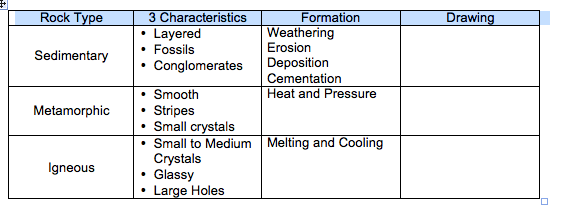Rock Cycle Crayon Lab
Summary
This lab allows students to see the changes taking place, and learn important qualities of each type of rock and how they are formed.
Materials
Attachments
- crayons
- penny
- paper towel
- aluminum foil
- aluminum pie tin
- 3 plastic cups (one with ice water, one with warm water, and one empty)
- ice
- alcohol burners
- textbooks
- student worksheet (attached)
Background for Teachers
Usually it's a hard concept for students to imagine that over millions of year one kind of rock will change into another kind of rock. This lab allows students to see the changes taking place, and learn important qualities of each type of rock and how they are formed.
Student Prior Knowledge
Students will be working with alcohol burners and molten wax, make sure all fire safety precautions are reviewed.
Instructional Procedures
- Have all supplies ready before the lab and make sure that you have many different colored crayons. The more opposite the colors the better the lab results.
- HOOK - Ask students the question "What makes you and your brothers and sisters related?" Expect answers like "we have the same parents or we look alike." (Be careful about singling a student out because some may not have siblings, or may be adopted). Follow up with the question "Can two different rocks be related?" Answers here may vary, and they time you spend in discussion about this is up to you. Hold up two different kinds of rocks that can directly turn from one to another on the rock cycle like limestone and marble (sedimentary and metamorphic) and review with the students similarities and differences between the rocks and ask, "How can these two rocks can be related?"
- Explain that relation in rocks is not the same as relation in humans, animals, and plants. For rocks, it all depends on what the environment does to the rock and has nothing to do with parents. Today we are going to see what can happen to the characteristics of rocks as their environment changes.
- In rocks, this process can take anywhere from minutes to millions of years depending on the kind of rock being made. It also requires temperatures and pressures that are impossible to contain here in the classroom. In place of rocks we are going to use crayons because the temperatures, pressures, and effects are just perfect for classroom use.
- Hand out the lab and read over all the instructions. There are questions, diagrams, and descriptions to do for just about every step so make sure the students see that.
- Be ready for some anything with the burners out, watch for students off task.
Assessment Plan
Attachments
Scoring Rubric:
1. Procedure 3 answer: sedimentary
2. Procedure 4 answer: metamorphic
3. Procedure 5 answer: igneous
Analysis questions 1-9:
- No, the shavings were not the same size or shape as before because we broke them down with the penny.
- The weathering agent was the penny. 3 weathering agents in nature are: water, wind, gravity, ice wedging, plants, etc.
- Rock sediments erode from gravity, water, wind, animals, etc.
- Rock sediments are deposited at the bottom of mountains, beaches, river deltas, etc.
- They are stuck together by cementation.
- A sedimentary rock needs a cementing agents and metamorphic rocks need heat and a lot of pressure.
- Igneous rocks are different depending on how they cool from a molten state. Molten rock cooling in water cool very fast and crystals are small. Molten rock cooling in a warmer area cool slower and have larger crystals.
- The different igneous rock samples are the same because they all came from molten rock. They are different because the size and shape of the cooled wax are very different (representing different sized crystals)
- (This is mostly for review)

Bibliography
Lesson Design by Jordan School District Teachers and Staff.
Updated: 02/05/2018


 UTAH EDUCATION NETWORK
UTAH EDUCATION NETWORK

 Justin
Justin Braxton
Braxton Dani
Dani Kayla
Kayla Katie
Katie Matthew
Matthew Rob
Rob Val
Val
